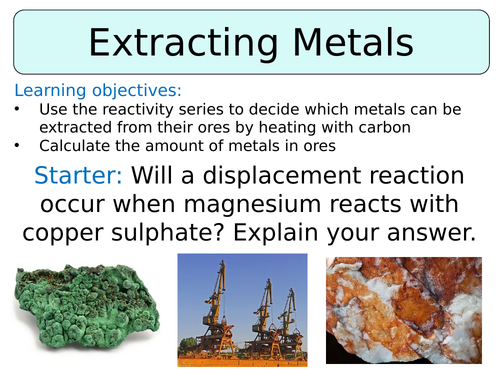
This lesson is designed for the KS3 Year 8 Science course, specifically the C2 1.2 unit on ‘Metals & Other Materials’.
For more lessons designed for KS3 and KS4 please visit my shop at: https://www.tes.com/teaching-resources/shop/SWiftScience.
The first task is for pupils to research, either using their phones or using laptops, the dates at which different metals were discovered. Once they have found the dates and filled in their table, they should consider the link between the reactivity of the metal and when it was discovered. After a class discussion of their ideas, students are introduced the idea of a metal ore.
The next task is for pupils to watch a video and answer questions on metal extraction, the answers to which are included in the PowerPoint presentation so students are able to self-assess their work.
The next part of the lesson focuses on how metals can be extracted from their ores, firstly students will be shown the position of carbon within the reactivity series. They will then be told that any metal below carbon in the reactivity series is able to be extracted from its oxide by a reaction with carbon. The general word equation for this reaction is shown to students, they can make a note of this in their books. They will then be asked to write down the complete word equations for the reactions of copper, iron and zinc with carbon. The mark scheme for this is provided on the PowerPoint presentation for students to mark and correct their work once complete.
Lastly, students need to be able to work out the amount of metal present in an ore. A worked example of this calculation is shown to students, they can make a note of the steps when approaching a question of this sort in their books. They will be then given a worksheet of questions to answer which requires students to calculate the masses of useful metal found in metal ores, as well as the waste. The mark scheme for this task is included in the PowerPoint so students can self or peer assess their work once it is complete.
The plenary requires students to write a Whatsapp message to friends, explaining what they have learned this lesson.
All resources are included at the end of the presentation. Thanks for looking, if you have any questions please let me know in the comments section and any feedback would be appreciated :)
Get this resource as part of a bundle and save up to 31%
A bundle is a package of resources grouped together to teach a particular topic, or a series of lessons, in one place.
Something went wrong, please try again later.
Good but the video doesn't exist.
Report this resourceto let us know if it violates our terms and conditions.
Our customer service team will review your report and will be in touch.
